MN2706K Human Resource Management Essay: Unionization Effectiveness
VerifiedAdded on 2022/10/16
|9
|2577
|421
Essay
AI Summary
This essay delves into the comparative effectiveness of unionization versus alternative forms of employee participation in human resource management. It explores the concept of employee involvement in organizational decision-making, highlighting various methods such as profit sharing, co-ownership, suggestion schemes, and trade unions. The essay emphasizes the significance of unionization, detailing its roles and responsibilities in representing employees, mediating between management and workers, and advocating for improved working conditions. It examines the benefits of unionization at political, social, and economic levels, including its influence on legislation, job security, and equal opportunities. Furthermore, the essay analyzes the functions of trade unions, encompassing fraternal support and militant actions, and underscores the importance of collective bargaining, negotiation, and, when necessary, methods like strikes to protect employee rights. The essay also discusses the advantages and disadvantages of unionization for both skilled and unskilled workers, and provides a case study of Singapore's trade union congress to illustrate the positive impacts of unionization on employers and employees. It contrasts unionized and non-unionized forms of participation, highlighting the limitations of the latter, particularly in terms of militant functions and dispute resolution, ultimately concluding that unionization is a more effective means of employee participation.
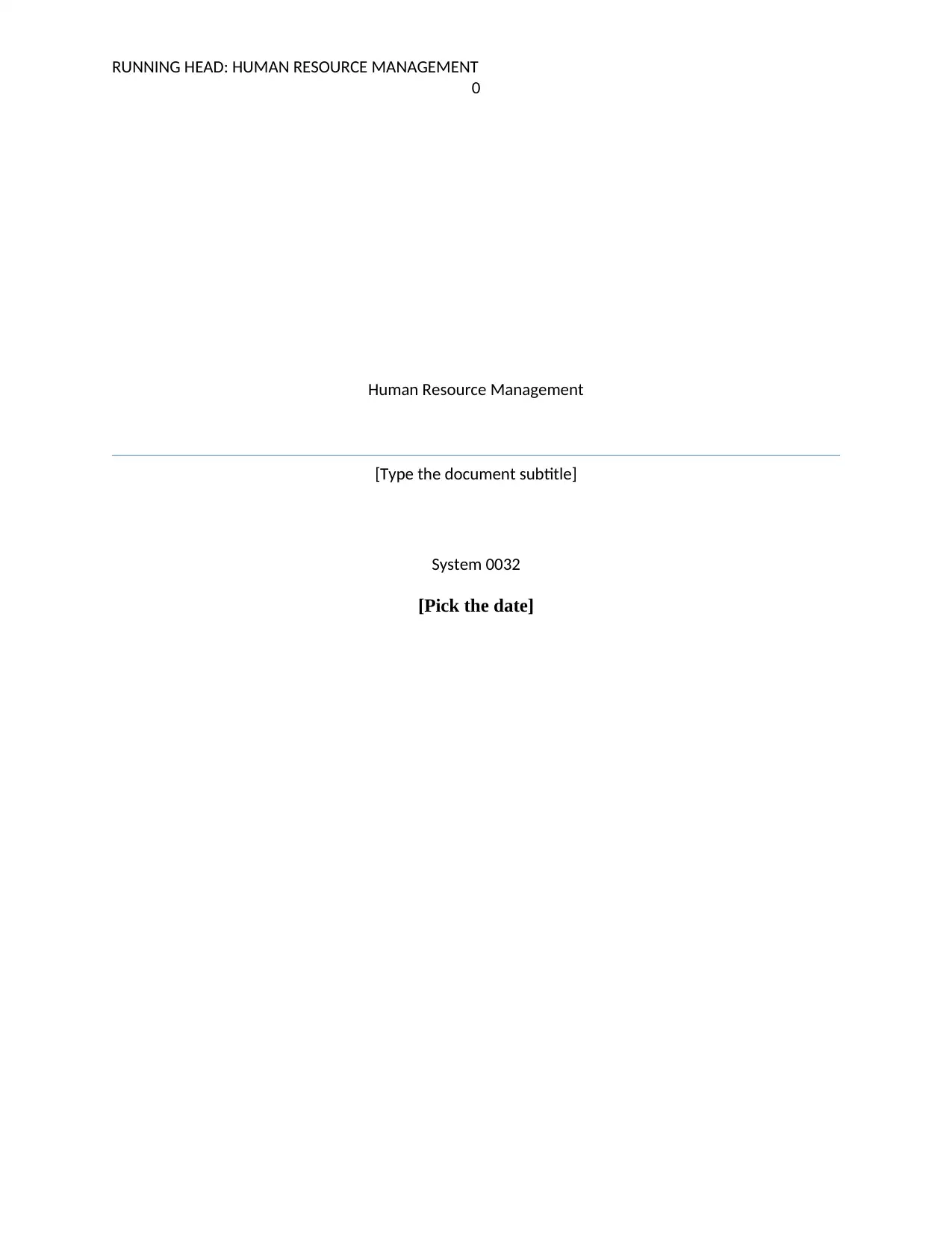
RUNNING HEAD: HUMAN RESOURCE MANAGEMENT
0
Human Resource Management
[Type the document subtitle]
System 0032
[Pick the date]
0
Human Resource Management
[Type the document subtitle]
System 0032
[Pick the date]
Paraphrase This Document
Need a fresh take? Get an instant paraphrase of this document with our AI Paraphraser
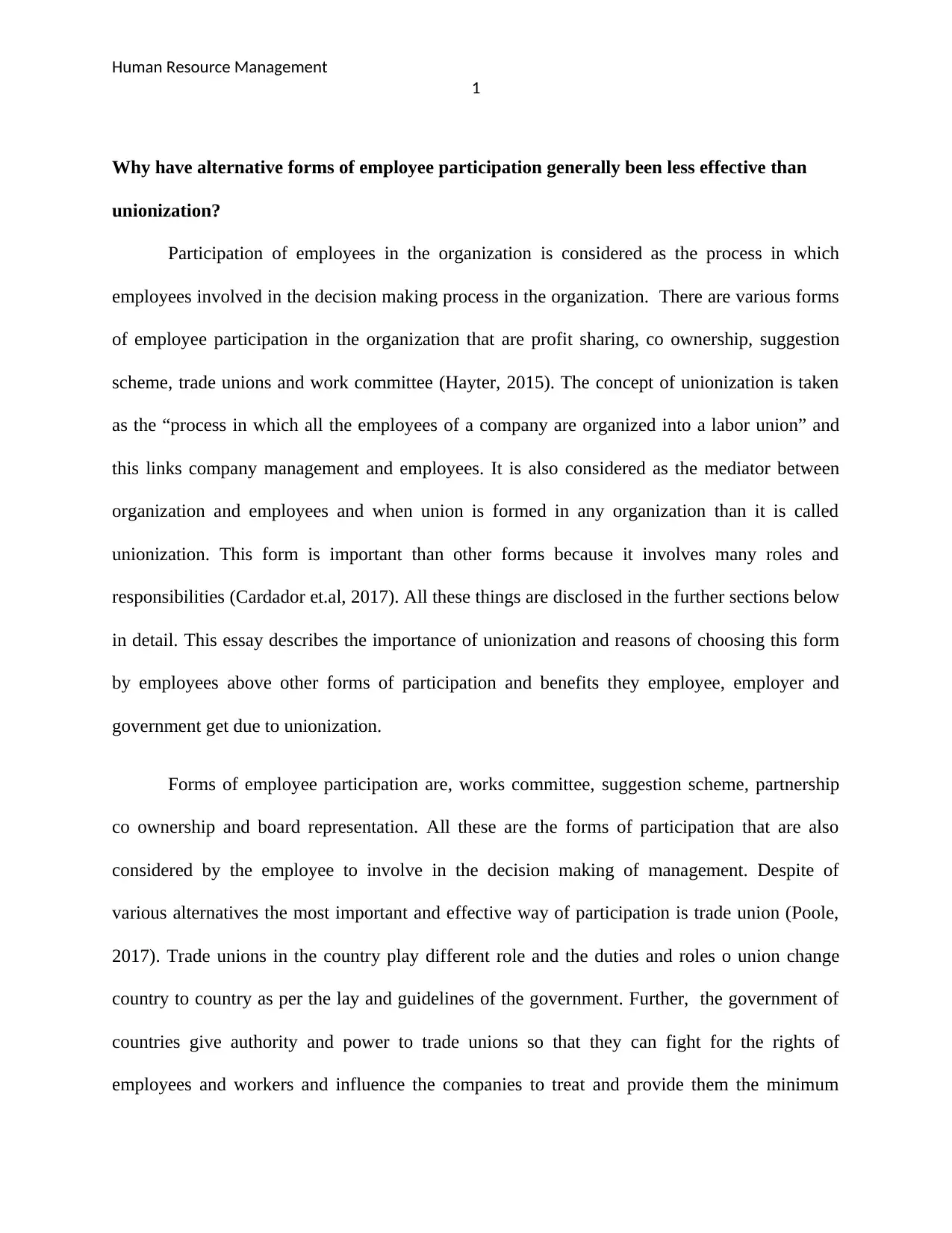
Human Resource Management
1
Why have alternative forms of employee participation generally been less effective than
unionization?
Participation of employees in the organization is considered as the process in which
employees involved in the decision making process in the organization. There are various forms
of employee participation in the organization that are profit sharing, co ownership, suggestion
scheme, trade unions and work committee (Hayter, 2015). The concept of unionization is taken
as the “process in which all the employees of a company are organized into a labor union” and
this links company management and employees. It is also considered as the mediator between
organization and employees and when union is formed in any organization than it is called
unionization. This form is important than other forms because it involves many roles and
responsibilities (Cardador et.al, 2017). All these things are disclosed in the further sections below
in detail. This essay describes the importance of unionization and reasons of choosing this form
by employees above other forms of participation and benefits they employee, employer and
government get due to unionization.
Forms of employee participation are, works committee, suggestion scheme, partnership
co ownership and board representation. All these are the forms of participation that are also
considered by the employee to involve in the decision making of management. Despite of
various alternatives the most important and effective way of participation is trade union (Poole,
2017). Trade unions in the country play different role and the duties and roles o union change
country to country as per the lay and guidelines of the government. Further, the government of
countries give authority and power to trade unions so that they can fight for the rights of
employees and workers and influence the companies to treat and provide them the minimum
1
Why have alternative forms of employee participation generally been less effective than
unionization?
Participation of employees in the organization is considered as the process in which
employees involved in the decision making process in the organization. There are various forms
of employee participation in the organization that are profit sharing, co ownership, suggestion
scheme, trade unions and work committee (Hayter, 2015). The concept of unionization is taken
as the “process in which all the employees of a company are organized into a labor union” and
this links company management and employees. It is also considered as the mediator between
organization and employees and when union is formed in any organization than it is called
unionization. This form is important than other forms because it involves many roles and
responsibilities (Cardador et.al, 2017). All these things are disclosed in the further sections below
in detail. This essay describes the importance of unionization and reasons of choosing this form
by employees above other forms of participation and benefits they employee, employer and
government get due to unionization.
Forms of employee participation are, works committee, suggestion scheme, partnership
co ownership and board representation. All these are the forms of participation that are also
considered by the employee to involve in the decision making of management. Despite of
various alternatives the most important and effective way of participation is trade union (Poole,
2017). Trade unions in the country play different role and the duties and roles o union change
country to country as per the lay and guidelines of the government. Further, the government of
countries give authority and power to trade unions so that they can fight for the rights of
employees and workers and influence the companies to treat and provide them the minimum
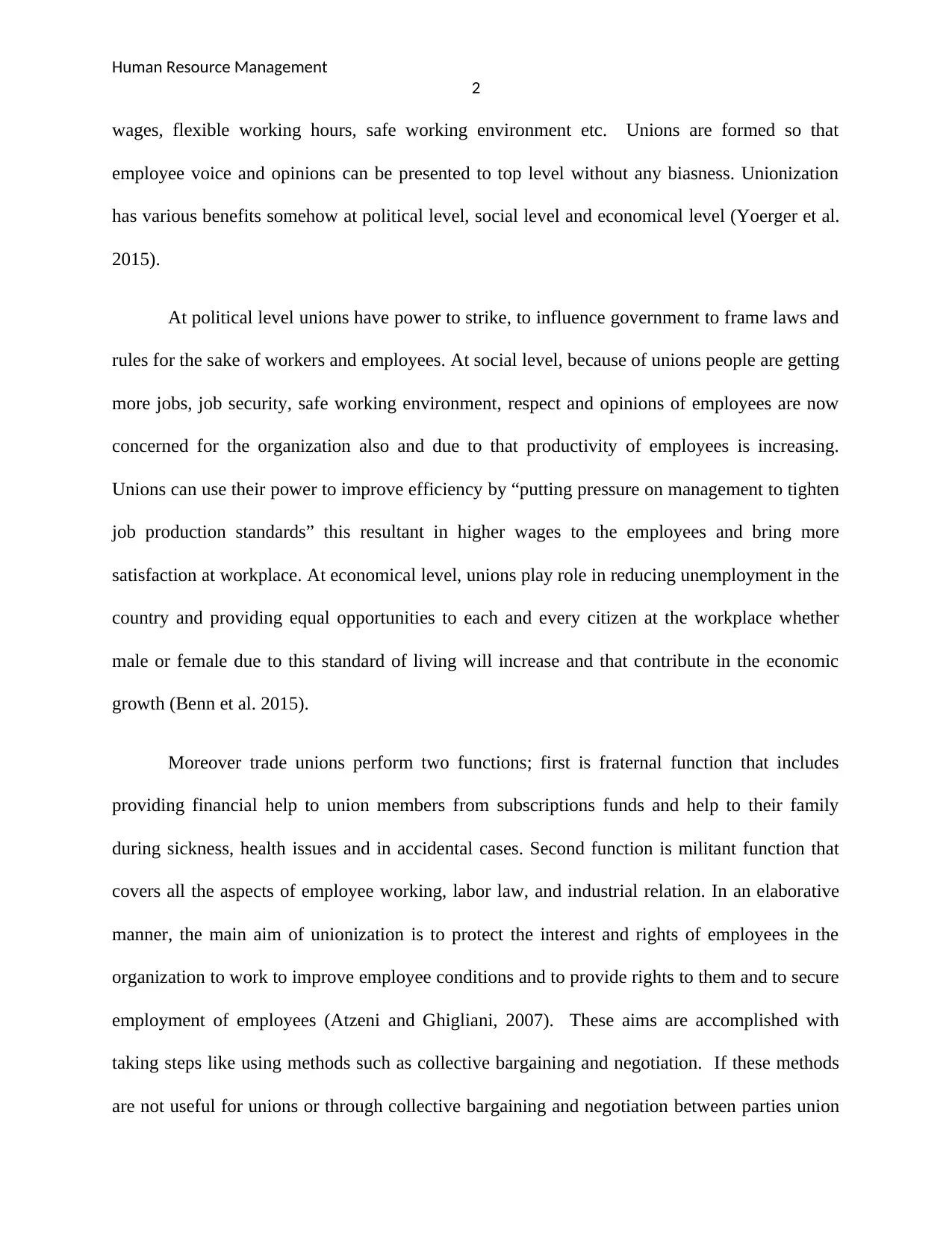
Human Resource Management
2
wages, flexible working hours, safe working environment etc. Unions are formed so that
employee voice and opinions can be presented to top level without any biasness. Unionization
has various benefits somehow at political level, social level and economical level (Yoerger et al.
2015).
At political level unions have power to strike, to influence government to frame laws and
rules for the sake of workers and employees. At social level, because of unions people are getting
more jobs, job security, safe working environment, respect and opinions of employees are now
concerned for the organization also and due to that productivity of employees is increasing.
Unions can use their power to improve efficiency by “putting pressure on management to tighten
job production standards” this resultant in higher wages to the employees and bring more
satisfaction at workplace. At economical level, unions play role in reducing unemployment in the
country and providing equal opportunities to each and every citizen at the workplace whether
male or female due to this standard of living will increase and that contribute in the economic
growth (Benn et al. 2015).
Moreover trade unions perform two functions; first is fraternal function that includes
providing financial help to union members from subscriptions funds and help to their family
during sickness, health issues and in accidental cases. Second function is militant function that
covers all the aspects of employee working, labor law, and industrial relation. In an elaborative
manner, the main aim of unionization is to protect the interest and rights of employees in the
organization to work to improve employee conditions and to provide rights to them and to secure
employment of employees (Atzeni and Ghigliani, 2007). These aims are accomplished with
taking steps like using methods such as collective bargaining and negotiation. If these methods
are not useful for unions or through collective bargaining and negotiation between parties union
2
wages, flexible working hours, safe working environment etc. Unions are formed so that
employee voice and opinions can be presented to top level without any biasness. Unionization
has various benefits somehow at political level, social level and economical level (Yoerger et al.
2015).
At political level unions have power to strike, to influence government to frame laws and
rules for the sake of workers and employees. At social level, because of unions people are getting
more jobs, job security, safe working environment, respect and opinions of employees are now
concerned for the organization also and due to that productivity of employees is increasing.
Unions can use their power to improve efficiency by “putting pressure on management to tighten
job production standards” this resultant in higher wages to the employees and bring more
satisfaction at workplace. At economical level, unions play role in reducing unemployment in the
country and providing equal opportunities to each and every citizen at the workplace whether
male or female due to this standard of living will increase and that contribute in the economic
growth (Benn et al. 2015).
Moreover trade unions perform two functions; first is fraternal function that includes
providing financial help to union members from subscriptions funds and help to their family
during sickness, health issues and in accidental cases. Second function is militant function that
covers all the aspects of employee working, labor law, and industrial relation. In an elaborative
manner, the main aim of unionization is to protect the interest and rights of employees in the
organization to work to improve employee conditions and to provide rights to them and to secure
employment of employees (Atzeni and Ghigliani, 2007). These aims are accomplished with
taking steps like using methods such as collective bargaining and negotiation. If these methods
are not useful for unions or through collective bargaining and negotiation between parties union
⊘ This is a preview!⊘
Do you want full access?
Subscribe today to unlock all pages.

Trusted by 1+ million students worldwide
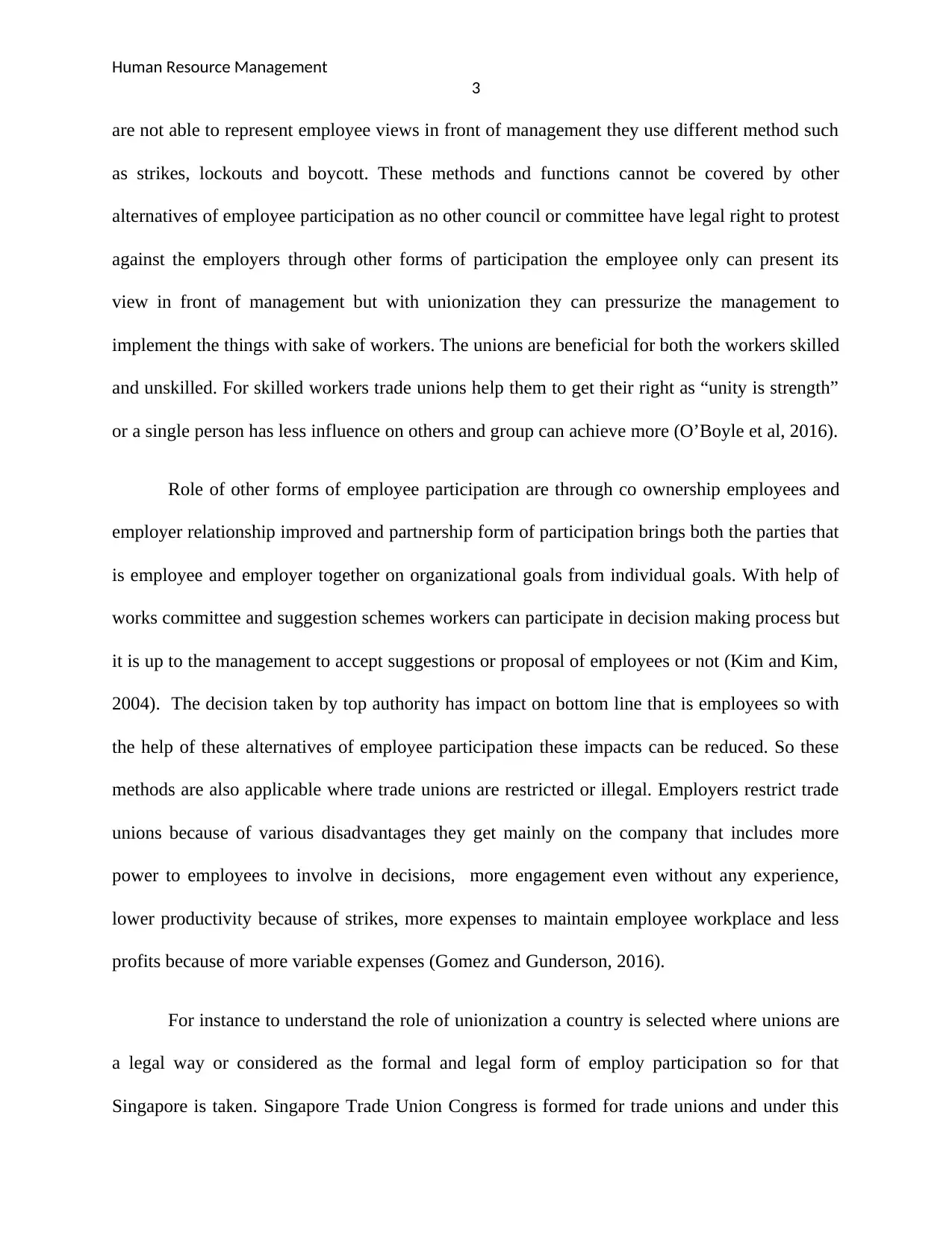
Human Resource Management
3
are not able to represent employee views in front of management they use different method such
as strikes, lockouts and boycott. These methods and functions cannot be covered by other
alternatives of employee participation as no other council or committee have legal right to protest
against the employers through other forms of participation the employee only can present its
view in front of management but with unionization they can pressurize the management to
implement the things with sake of workers. The unions are beneficial for both the workers skilled
and unskilled. For skilled workers trade unions help them to get their right as “unity is strength”
or a single person has less influence on others and group can achieve more (O’Boyle et al, 2016).
Role of other forms of employee participation are through co ownership employees and
employer relationship improved and partnership form of participation brings both the parties that
is employee and employer together on organizational goals from individual goals. With help of
works committee and suggestion schemes workers can participate in decision making process but
it is up to the management to accept suggestions or proposal of employees or not (Kim and Kim,
2004). The decision taken by top authority has impact on bottom line that is employees so with
the help of these alternatives of employee participation these impacts can be reduced. So these
methods are also applicable where trade unions are restricted or illegal. Employers restrict trade
unions because of various disadvantages they get mainly on the company that includes more
power to employees to involve in decisions, more engagement even without any experience,
lower productivity because of strikes, more expenses to maintain employee workplace and less
profits because of more variable expenses (Gomez and Gunderson, 2016).
For instance to understand the role of unionization a country is selected where unions are
a legal way or considered as the formal and legal form of employ participation so for that
Singapore is taken. Singapore Trade Union Congress is formed for trade unions and under this
3
are not able to represent employee views in front of management they use different method such
as strikes, lockouts and boycott. These methods and functions cannot be covered by other
alternatives of employee participation as no other council or committee have legal right to protest
against the employers through other forms of participation the employee only can present its
view in front of management but with unionization they can pressurize the management to
implement the things with sake of workers. The unions are beneficial for both the workers skilled
and unskilled. For skilled workers trade unions help them to get their right as “unity is strength”
or a single person has less influence on others and group can achieve more (O’Boyle et al, 2016).
Role of other forms of employee participation are through co ownership employees and
employer relationship improved and partnership form of participation brings both the parties that
is employee and employer together on organizational goals from individual goals. With help of
works committee and suggestion schemes workers can participate in decision making process but
it is up to the management to accept suggestions or proposal of employees or not (Kim and Kim,
2004). The decision taken by top authority has impact on bottom line that is employees so with
the help of these alternatives of employee participation these impacts can be reduced. So these
methods are also applicable where trade unions are restricted or illegal. Employers restrict trade
unions because of various disadvantages they get mainly on the company that includes more
power to employees to involve in decisions, more engagement even without any experience,
lower productivity because of strikes, more expenses to maintain employee workplace and less
profits because of more variable expenses (Gomez and Gunderson, 2016).
For instance to understand the role of unionization a country is selected where unions are
a legal way or considered as the formal and legal form of employ participation so for that
Singapore is taken. Singapore Trade Union Congress is formed for trade unions and under this
Paraphrase This Document
Need a fresh take? Get an instant paraphrase of this document with our AI Paraphraser
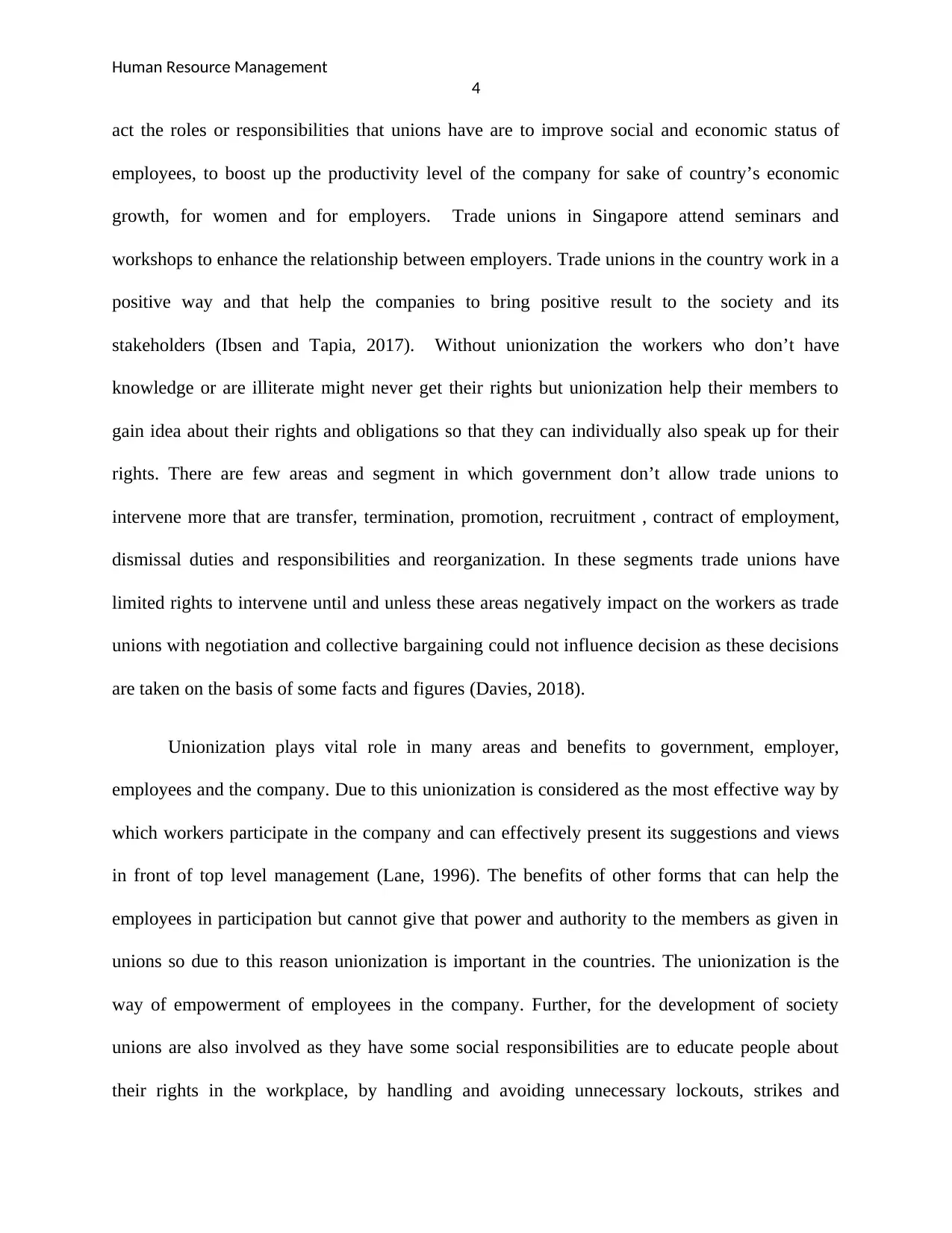
Human Resource Management
4
act the roles or responsibilities that unions have are to improve social and economic status of
employees, to boost up the productivity level of the company for sake of country’s economic
growth, for women and for employers. Trade unions in Singapore attend seminars and
workshops to enhance the relationship between employers. Trade unions in the country work in a
positive way and that help the companies to bring positive result to the society and its
stakeholders (Ibsen and Tapia, 2017). Without unionization the workers who don’t have
knowledge or are illiterate might never get their rights but unionization help their members to
gain idea about their rights and obligations so that they can individually also speak up for their
rights. There are few areas and segment in which government don’t allow trade unions to
intervene more that are transfer, termination, promotion, recruitment , contract of employment,
dismissal duties and responsibilities and reorganization. In these segments trade unions have
limited rights to intervene until and unless these areas negatively impact on the workers as trade
unions with negotiation and collective bargaining could not influence decision as these decisions
are taken on the basis of some facts and figures (Davies, 2018).
Unionization plays vital role in many areas and benefits to government, employer,
employees and the company. Due to this unionization is considered as the most effective way by
which workers participate in the company and can effectively present its suggestions and views
in front of top level management (Lane, 1996). The benefits of other forms that can help the
employees in participation but cannot give that power and authority to the members as given in
unions so due to this reason unionization is important in the countries. The unionization is the
way of empowerment of employees in the company. Further, for the development of society
unions are also involved as they have some social responsibilities are to educate people about
their rights in the workplace, by handling and avoiding unnecessary lockouts, strikes and
4
act the roles or responsibilities that unions have are to improve social and economic status of
employees, to boost up the productivity level of the company for sake of country’s economic
growth, for women and for employers. Trade unions in Singapore attend seminars and
workshops to enhance the relationship between employers. Trade unions in the country work in a
positive way and that help the companies to bring positive result to the society and its
stakeholders (Ibsen and Tapia, 2017). Without unionization the workers who don’t have
knowledge or are illiterate might never get their rights but unionization help their members to
gain idea about their rights and obligations so that they can individually also speak up for their
rights. There are few areas and segment in which government don’t allow trade unions to
intervene more that are transfer, termination, promotion, recruitment , contract of employment,
dismissal duties and responsibilities and reorganization. In these segments trade unions have
limited rights to intervene until and unless these areas negatively impact on the workers as trade
unions with negotiation and collective bargaining could not influence decision as these decisions
are taken on the basis of some facts and figures (Davies, 2018).
Unionization plays vital role in many areas and benefits to government, employer,
employees and the company. Due to this unionization is considered as the most effective way by
which workers participate in the company and can effectively present its suggestions and views
in front of top level management (Lane, 1996). The benefits of other forms that can help the
employees in participation but cannot give that power and authority to the members as given in
unions so due to this reason unionization is important in the countries. The unionization is the
way of empowerment of employees in the company. Further, for the development of society
unions are also involved as they have some social responsibilities are to educate people about
their rights in the workplace, by handling and avoiding unnecessary lockouts, strikes and
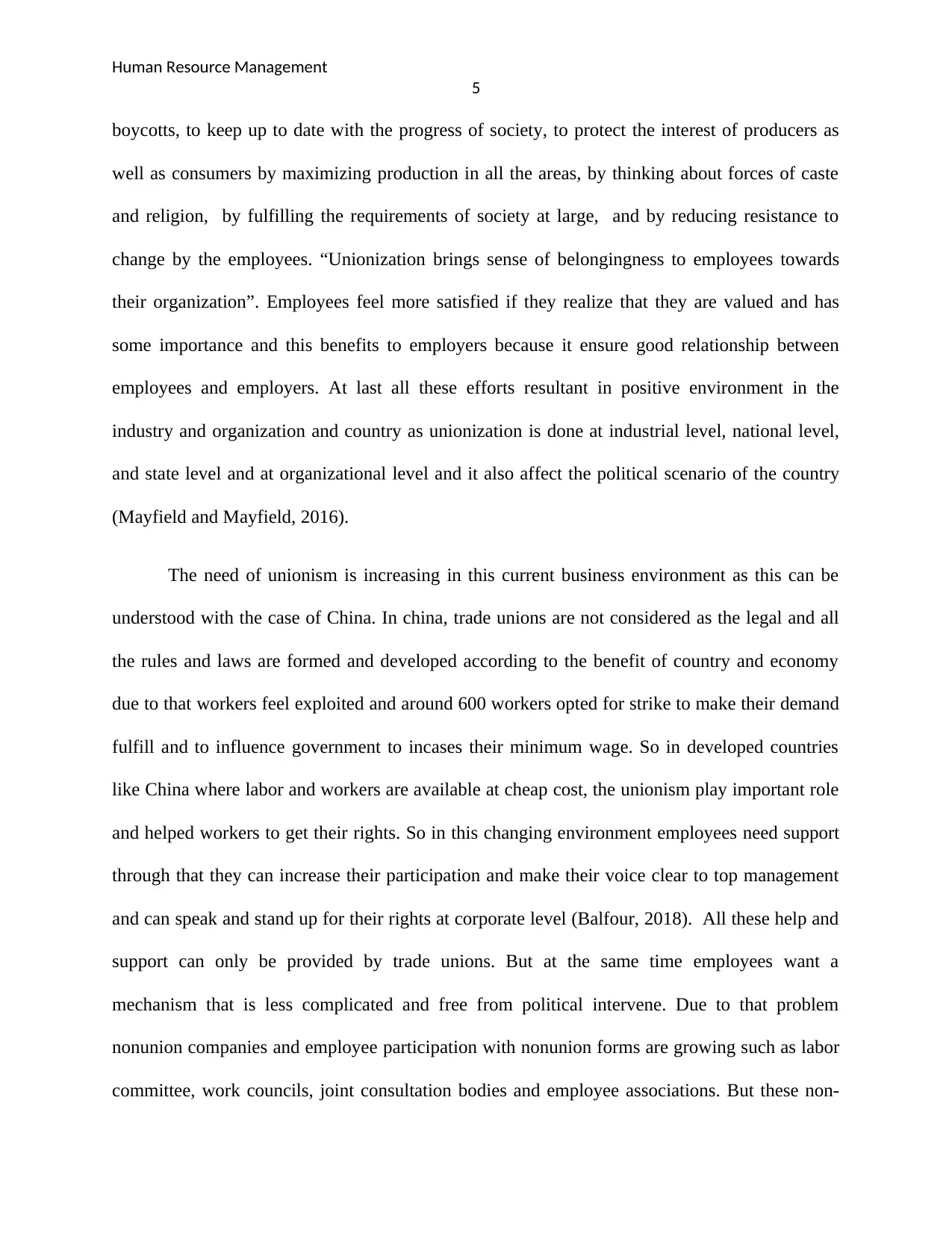
Human Resource Management
5
boycotts, to keep up to date with the progress of society, to protect the interest of producers as
well as consumers by maximizing production in all the areas, by thinking about forces of caste
and religion, by fulfilling the requirements of society at large, and by reducing resistance to
change by the employees. “Unionization brings sense of belongingness to employees towards
their organization”. Employees feel more satisfied if they realize that they are valued and has
some importance and this benefits to employers because it ensure good relationship between
employees and employers. At last all these efforts resultant in positive environment in the
industry and organization and country as unionization is done at industrial level, national level,
and state level and at organizational level and it also affect the political scenario of the country
(Mayfield and Mayfield, 2016).
The need of unionism is increasing in this current business environment as this can be
understood with the case of China. In china, trade unions are not considered as the legal and all
the rules and laws are formed and developed according to the benefit of country and economy
due to that workers feel exploited and around 600 workers opted for strike to make their demand
fulfill and to influence government to incases their minimum wage. So in developed countries
like China where labor and workers are available at cheap cost, the unionism play important role
and helped workers to get their rights. So in this changing environment employees need support
through that they can increase their participation and make their voice clear to top management
and can speak and stand up for their rights at corporate level (Balfour, 2018). All these help and
support can only be provided by trade unions. But at the same time employees want a
mechanism that is less complicated and free from political intervene. Due to that problem
nonunion companies and employee participation with nonunion forms are growing such as labor
committee, work councils, joint consultation bodies and employee associations. But these non-
5
boycotts, to keep up to date with the progress of society, to protect the interest of producers as
well as consumers by maximizing production in all the areas, by thinking about forces of caste
and religion, by fulfilling the requirements of society at large, and by reducing resistance to
change by the employees. “Unionization brings sense of belongingness to employees towards
their organization”. Employees feel more satisfied if they realize that they are valued and has
some importance and this benefits to employers because it ensure good relationship between
employees and employers. At last all these efforts resultant in positive environment in the
industry and organization and country as unionization is done at industrial level, national level,
and state level and at organizational level and it also affect the political scenario of the country
(Mayfield and Mayfield, 2016).
The need of unionism is increasing in this current business environment as this can be
understood with the case of China. In china, trade unions are not considered as the legal and all
the rules and laws are formed and developed according to the benefit of country and economy
due to that workers feel exploited and around 600 workers opted for strike to make their demand
fulfill and to influence government to incases their minimum wage. So in developed countries
like China where labor and workers are available at cheap cost, the unionism play important role
and helped workers to get their rights. So in this changing environment employees need support
through that they can increase their participation and make their voice clear to top management
and can speak and stand up for their rights at corporate level (Balfour, 2018). All these help and
support can only be provided by trade unions. But at the same time employees want a
mechanism that is less complicated and free from political intervene. Due to that problem
nonunion companies and employee participation with nonunion forms are growing such as labor
committee, work councils, joint consultation bodies and employee associations. But these non-
⊘ This is a preview!⊘
Do you want full access?
Subscribe today to unlock all pages.

Trusted by 1+ million students worldwide
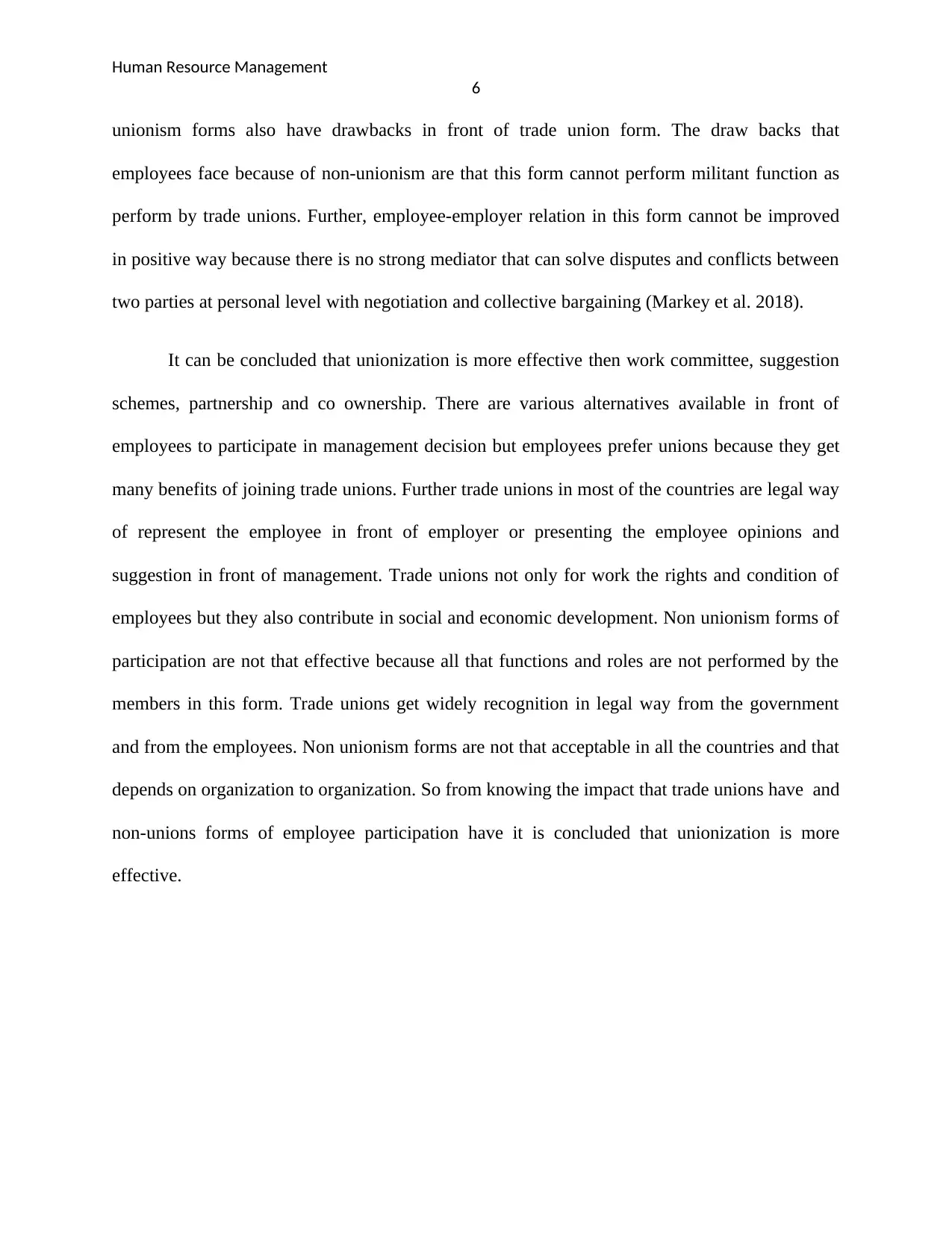
Human Resource Management
6
unionism forms also have drawbacks in front of trade union form. The draw backs that
employees face because of non-unionism are that this form cannot perform militant function as
perform by trade unions. Further, employee-employer relation in this form cannot be improved
in positive way because there is no strong mediator that can solve disputes and conflicts between
two parties at personal level with negotiation and collective bargaining (Markey et al. 2018).
It can be concluded that unionization is more effective then work committee, suggestion
schemes, partnership and co ownership. There are various alternatives available in front of
employees to participate in management decision but employees prefer unions because they get
many benefits of joining trade unions. Further trade unions in most of the countries are legal way
of represent the employee in front of employer or presenting the employee opinions and
suggestion in front of management. Trade unions not only for work the rights and condition of
employees but they also contribute in social and economic development. Non unionism forms of
participation are not that effective because all that functions and roles are not performed by the
members in this form. Trade unions get widely recognition in legal way from the government
and from the employees. Non unionism forms are not that acceptable in all the countries and that
depends on organization to organization. So from knowing the impact that trade unions have and
non-unions forms of employee participation have it is concluded that unionization is more
effective.
6
unionism forms also have drawbacks in front of trade union form. The draw backs that
employees face because of non-unionism are that this form cannot perform militant function as
perform by trade unions. Further, employee-employer relation in this form cannot be improved
in positive way because there is no strong mediator that can solve disputes and conflicts between
two parties at personal level with negotiation and collective bargaining (Markey et al. 2018).
It can be concluded that unionization is more effective then work committee, suggestion
schemes, partnership and co ownership. There are various alternatives available in front of
employees to participate in management decision but employees prefer unions because they get
many benefits of joining trade unions. Further trade unions in most of the countries are legal way
of represent the employee in front of employer or presenting the employee opinions and
suggestion in front of management. Trade unions not only for work the rights and condition of
employees but they also contribute in social and economic development. Non unionism forms of
participation are not that effective because all that functions and roles are not performed by the
members in this form. Trade unions get widely recognition in legal way from the government
and from the employees. Non unionism forms are not that acceptable in all the countries and that
depends on organization to organization. So from knowing the impact that trade unions have and
non-unions forms of employee participation have it is concluded that unionization is more
effective.
Paraphrase This Document
Need a fresh take? Get an instant paraphrase of this document with our AI Paraphraser
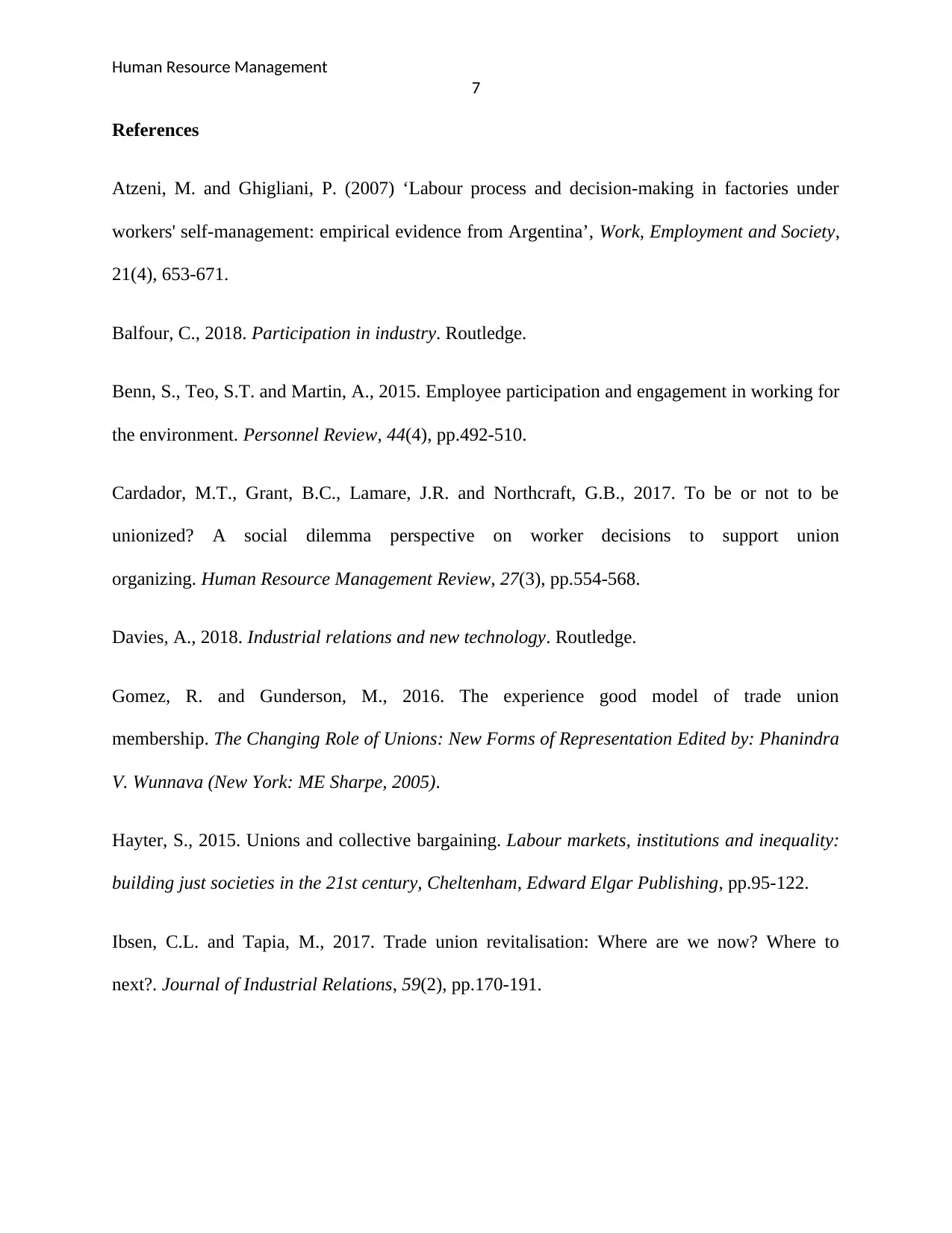
Human Resource Management
7
References
Atzeni, M. and Ghigliani, P. (2007) ‘Labour process and decision-making in factories under
workers' self-management: empirical evidence from Argentina’, Work, Employment and Society,
21(4), 653-671.
Balfour, C., 2018. Participation in industry. Routledge.
Benn, S., Teo, S.T. and Martin, A., 2015. Employee participation and engagement in working for
the environment. Personnel Review, 44(4), pp.492-510.
Cardador, M.T., Grant, B.C., Lamare, J.R. and Northcraft, G.B., 2017. To be or not to be
unionized? A social dilemma perspective on worker decisions to support union
organizing. Human Resource Management Review, 27(3), pp.554-568.
Davies, A., 2018. Industrial relations and new technology. Routledge.
Gomez, R. and Gunderson, M., 2016. The experience good model of trade union
membership. The Changing Role of Unions: New Forms of Representation Edited by: Phanindra
V. Wunnava (New York: ME Sharpe, 2005).
Hayter, S., 2015. Unions and collective bargaining. Labour markets, institutions and inequality:
building just societies in the 21st century, Cheltenham, Edward Elgar Publishing, pp.95-122.
Ibsen, C.L. and Tapia, M., 2017. Trade union revitalisation: Where are we now? Where to
next?. Journal of Industrial Relations, 59(2), pp.170-191.
7
References
Atzeni, M. and Ghigliani, P. (2007) ‘Labour process and decision-making in factories under
workers' self-management: empirical evidence from Argentina’, Work, Employment and Society,
21(4), 653-671.
Balfour, C., 2018. Participation in industry. Routledge.
Benn, S., Teo, S.T. and Martin, A., 2015. Employee participation and engagement in working for
the environment. Personnel Review, 44(4), pp.492-510.
Cardador, M.T., Grant, B.C., Lamare, J.R. and Northcraft, G.B., 2017. To be or not to be
unionized? A social dilemma perspective on worker decisions to support union
organizing. Human Resource Management Review, 27(3), pp.554-568.
Davies, A., 2018. Industrial relations and new technology. Routledge.
Gomez, R. and Gunderson, M., 2016. The experience good model of trade union
membership. The Changing Role of Unions: New Forms of Representation Edited by: Phanindra
V. Wunnava (New York: ME Sharpe, 2005).
Hayter, S., 2015. Unions and collective bargaining. Labour markets, institutions and inequality:
building just societies in the 21st century, Cheltenham, Edward Elgar Publishing, pp.95-122.
Ibsen, C.L. and Tapia, M., 2017. Trade union revitalisation: Where are we now? Where to
next?. Journal of Industrial Relations, 59(2), pp.170-191.
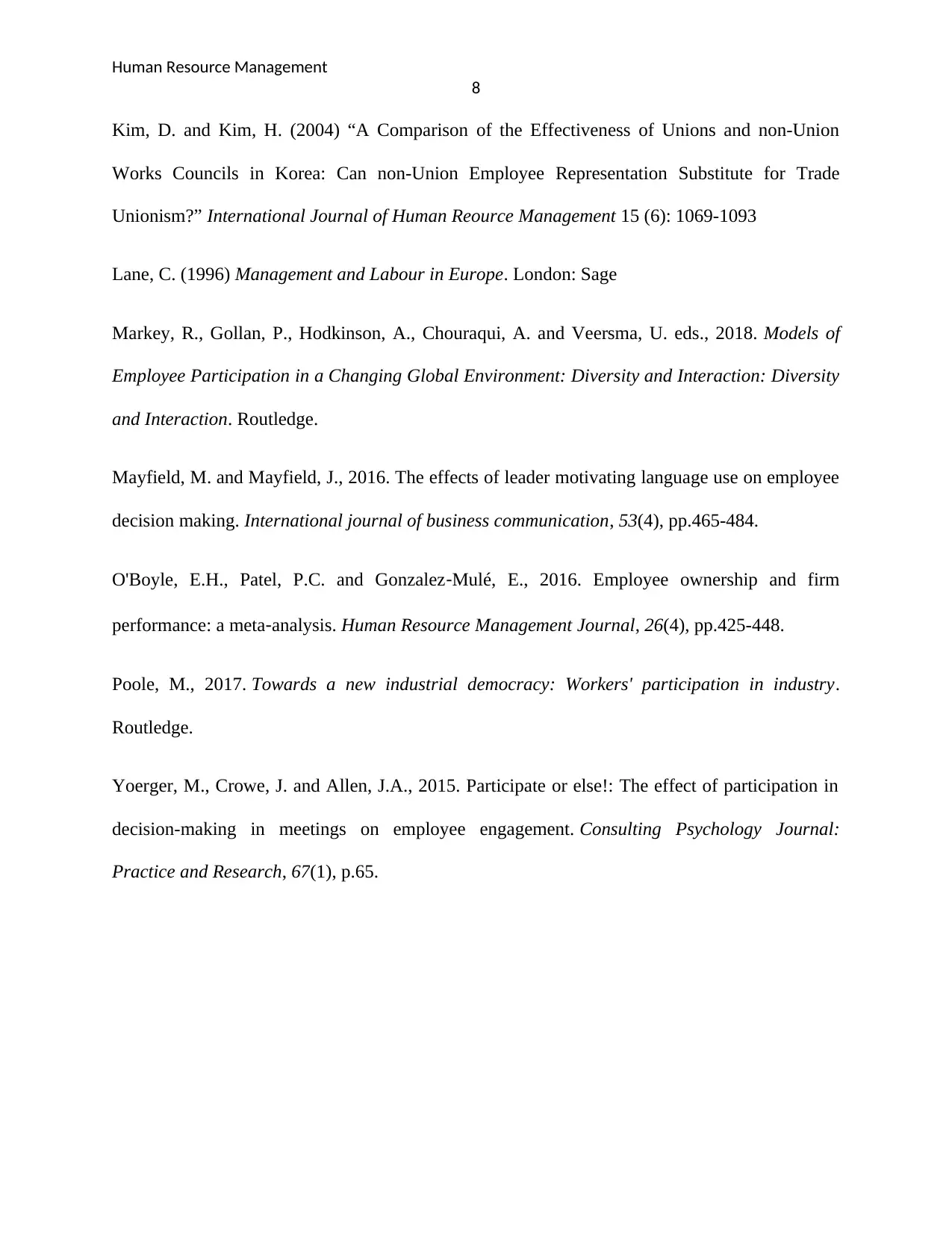
Human Resource Management
8
Kim, D. and Kim, H. (2004) “A Comparison of the Effectiveness of Unions and non-Union
Works Councils in Korea: Can non-Union Employee Representation Substitute for Trade
Unionism?” International Journal of Human Reource Management 15 (6): 1069-1093
Lane, C. (1996) Management and Labour in Europe. London: Sage
Markey, R., Gollan, P., Hodkinson, A., Chouraqui, A. and Veersma, U. eds., 2018. Models of
Employee Participation in a Changing Global Environment: Diversity and Interaction: Diversity
and Interaction. Routledge.
Mayfield, M. and Mayfield, J., 2016. The effects of leader motivating language use on employee
decision making. International journal of business communication, 53(4), pp.465-484.
O'Boyle, E.H., Patel, P.C. and Gonzalez‐Mulé, E., 2016. Employee ownership and firm
performance: a meta‐analysis. Human Resource Management Journal, 26(4), pp.425-448.
Poole, M., 2017. Towards a new industrial democracy: Workers' participation in industry.
Routledge.
Yoerger, M., Crowe, J. and Allen, J.A., 2015. Participate or else!: The effect of participation in
decision-making in meetings on employee engagement. Consulting Psychology Journal:
Practice and Research, 67(1), p.65.
8
Kim, D. and Kim, H. (2004) “A Comparison of the Effectiveness of Unions and non-Union
Works Councils in Korea: Can non-Union Employee Representation Substitute for Trade
Unionism?” International Journal of Human Reource Management 15 (6): 1069-1093
Lane, C. (1996) Management and Labour in Europe. London: Sage
Markey, R., Gollan, P., Hodkinson, A., Chouraqui, A. and Veersma, U. eds., 2018. Models of
Employee Participation in a Changing Global Environment: Diversity and Interaction: Diversity
and Interaction. Routledge.
Mayfield, M. and Mayfield, J., 2016. The effects of leader motivating language use on employee
decision making. International journal of business communication, 53(4), pp.465-484.
O'Boyle, E.H., Patel, P.C. and Gonzalez‐Mulé, E., 2016. Employee ownership and firm
performance: a meta‐analysis. Human Resource Management Journal, 26(4), pp.425-448.
Poole, M., 2017. Towards a new industrial democracy: Workers' participation in industry.
Routledge.
Yoerger, M., Crowe, J. and Allen, J.A., 2015. Participate or else!: The effect of participation in
decision-making in meetings on employee engagement. Consulting Psychology Journal:
Practice and Research, 67(1), p.65.
⊘ This is a preview!⊘
Do you want full access?
Subscribe today to unlock all pages.

Trusted by 1+ million students worldwide
1 out of 9
Related Documents
Your All-in-One AI-Powered Toolkit for Academic Success.
+13062052269
info@desklib.com
Available 24*7 on WhatsApp / Email
![[object Object]](/_next/static/media/star-bottom.7253800d.svg)
Unlock your academic potential
Copyright © 2020–2025 A2Z Services. All Rights Reserved. Developed and managed by ZUCOL.





